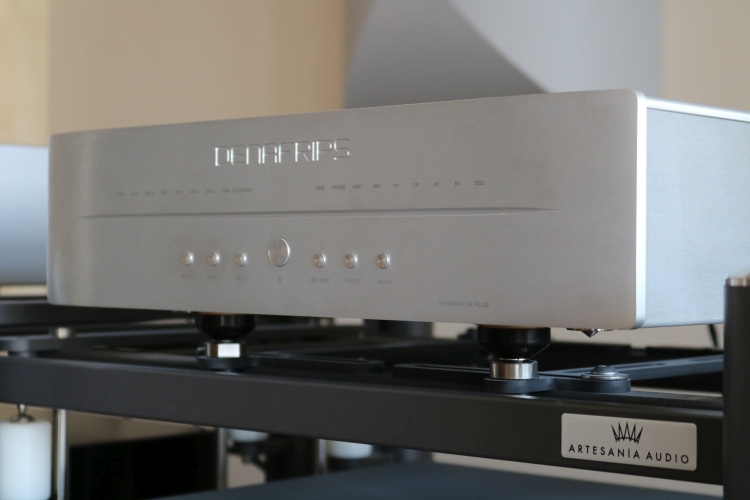
Review sample supplied by Vinshine Audio
Retail price including 21% VAT: 7.000 euro
My first contact with Alvin Chee of Vinshine Audio was for reviewing the Jay’s Audio CDT-2Mk2 CD transport and the DAC-2 Signature and later for reviewing the Denafrips Venus DAC. That’s when I learned that Denafrips was something special. As is clearly articulated in the review I truly enjoyed the Jay’s components but even if the Venus did not do everything as well, my time with it made it very clear that the Denafrips performed on an entirely different audiophile level. At that time already knowing of the Terminator’s existence, and having read so many glowing reviews, I quickly agreed when Alvin asked me to review the latest and greatest range-topping Terminator Plus DAC. Since the DAC had just been reviewed by fellow reviewer Jaap of Alpha Audio who is also based in the Netherlands, the unit could be in my hands in a matter of days.
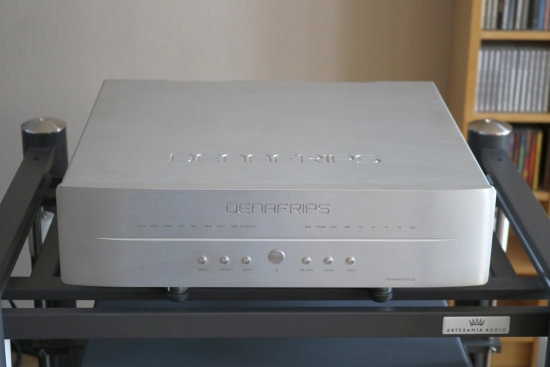
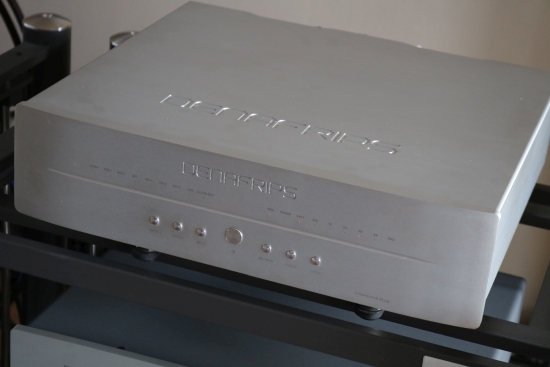
Upon receipt, the unit proved suitably heavy and is impressively built. All of its edges are finished smoothly and all the buttons work precisely and confidently. The indicator LEDs are fitted Jeff-Rowland-style: highly sophisticated with tiny holes and precisely trimmed to the right brightness. Its origins are only visible in the quality of the aluminum which, somehow, often looks a little spotty or unpolished with products (or enclosures) of direct Chinese origin. Please note that I made sure to clean the unit prior to taking any photos, so what you’re seeing is not dirt or fingerprints. On the inside, however, the unit is absolutely top-shelf.
Technical Aspects
The Terminator Plus can be seen as the non-plus-ultra version of the 3.750 euro (+VAT) Terminator II, which is the bigger brother of the Venus II, of which I reviewed the original Venus version a while ago.
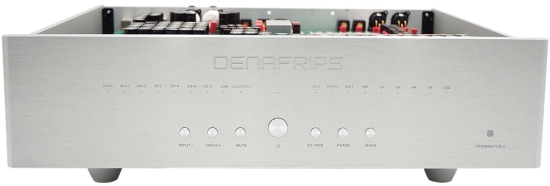
Above: Terminator II, below: Terminator Plus
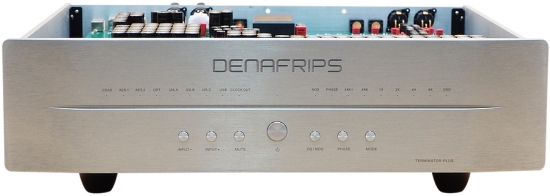
Since the Terminator II is actually the trickle-down version of the Terminator Plus, the two DACs are very similar not only externally, but also internally. According to a quote from the manufacturer, the main differences between the II and the Plus are the curved aluminum front panel, precision, hand-picked, premium OCXO, and hand-picked R-2R resistors. Further, it’s mentioned in the specifications that the dual OCXO’s are powered by a completely redesigned power supply circuitry. And indeed, from looking at pictures of the two DACs’ internals, I can see that the clocks in the new model have a different and larger enclosure, and four big red square capacitors (presumably big WIMAs) have been replaced by large rows of smaller WIMA MKS types. All the other capacitors are Elna Silmic II types.
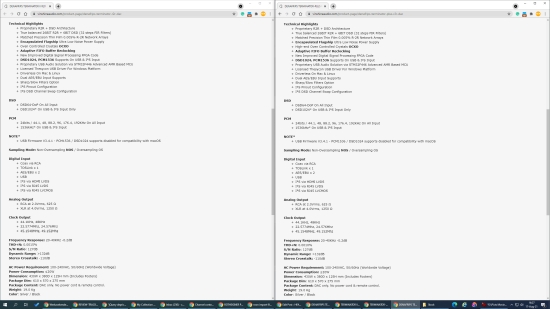
Seek the differences… I know it’s unreadable in this size but, trust me, each and every parameter has the same value for the Terminator II and Terminator Plus, except for the Total Harmonic Distortion and Noise, which went down from 0.0018 to 0.0010%. While these numbers are vanishingly small and may not mean much for the end result, it has been proven time and again that component changes can have significant audible effects even when they are not measurable using the standard methods.
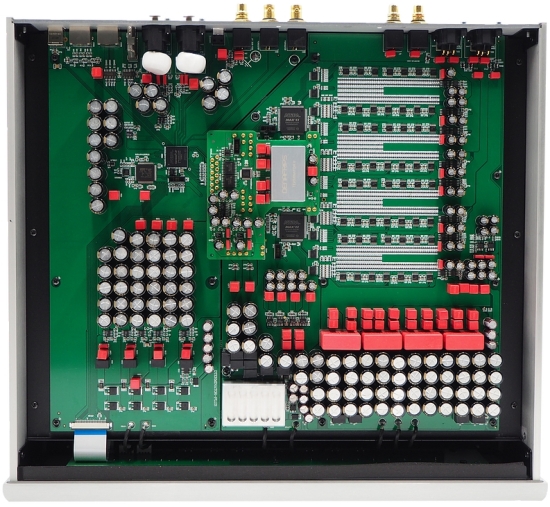
Above: Terminator II, below: Terminator Plus
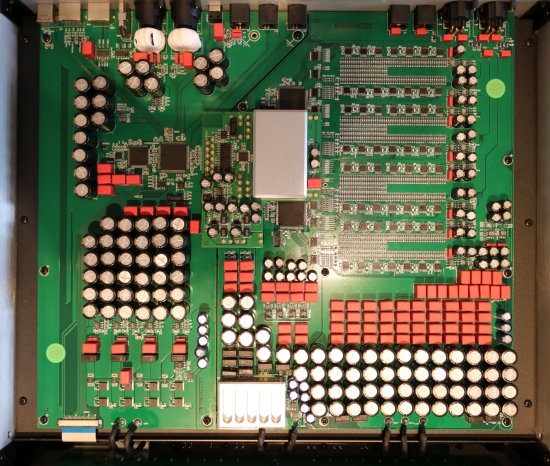
The Terminator Plus contains the company’s fourth proprietary generation of discrete-resistor 26Bit R-2R for PCM decoding and 6Bit DSD hardware decoding with 32 steps FIR filters. DSD64 DoP and PCM 24bit 44.1, 48, 88.2, 96, 176.4, 192 kHz is accepted on all inputs while DSD1024 and PCM 1536 kHz are accepted on USB & I²S Input Only. Speaking of which, the USB connection is a proprietary solution implemented via an STM32F446 advanced AMR-based MCU. The I²S Pinout can be configured according to the PS Audio or the Denafrips standard.
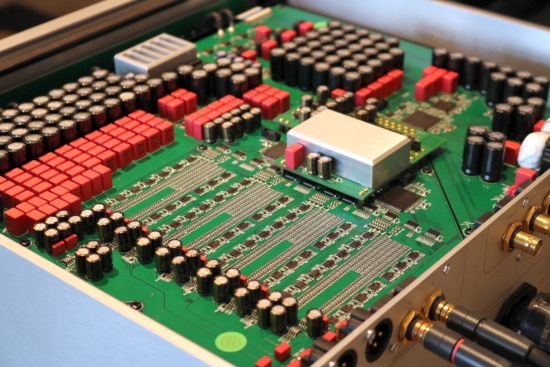
The core conversion R-2R module is constructed using 0.005% high precision, 10ppm low thermal effect precision resistors. Each channel uses more than 500pcs of these precision resistors, or 1000pcs for two channels which, according to the manufacturer, amounts to 4 times more than other typical R-2R DACs. The Digital Processing Board and R-2R ladder network arrays are completely isolated, physically linked only by the OCXO module.
The dual OCXO’s operate at 45.1584Mhz and 49.152Mhz. Encapsulated in a metal casing and located at the center of the DAC, these OCXO are specially designed for high-end audio applications with ultra-low phase noise and ultra-accuracy.
The Terminator Plus’ high-precision OCXO’s can be utilized not only internally by the DAC itself, but its dual clock outputs can also be used to synchronize external devices that support audio frequencies of 44.1KHz, 48KHz, 22.5792Mhz, 24.576Mhz, 45.1584MHz, or 49.152Mhz. Alternatively, the DAC can be synced to an external clock, for instance, the Denafrips Gaia.
Jitter is addressed by a reclocking FIFO buffer. The adaptive buffer stores the digital audio data in memory, from which the data is read using the ultra-low phase noise, ultra-accuracy OCXO after which the data is converted to analog by the true balanced R-2R ladder network arrays. The linearity of the conversion is guaranteed by the high-precision thin-film resistors, with a low thermal effect temperature coefficient of 10/15ppm.
The unit is powered by a fully encapsulated dual O-Core linear power supply with separate transformers for the analog and digital sections. The power supply is built using ultra-low ESR, long-endurance reservoir capacitors, and multi-stage linear regulation. The supply is built within a separate metal alloy enclosure that is mounted underneath the DAC board, with an additional steel plate divider for extra shielding. According to the manufacturer, this box-within-a-box design eliminates the inherent problems of dual box solutions and is a big reason for the DAC’s capability to present micro-details.

The Terminator Plus (as well as the TII) offers a wealth of inputs: 1x Coax, 1x Toslink, 2x AES/EBU. 1x I²S on HDMI, 2x I²S on RJ45, and 1x USB.
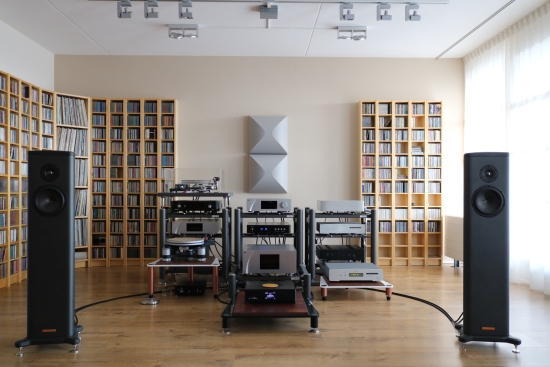
System Context
For this review, I used my main system, in the basis consisting of the CH C1 DAC, CH A1.5 power amp, and Magico S1 MkII speakers. For digital sources, I will use the Grimm MU1 and Antipodes K50 music servers, and the Aqua LinQ network interface/streaming endpoint with the Core+NAA module. For the bulk of the comparisons, I will use the Aqua Formula xHD DAC with V2 output board. As my main CH DAC is normally connected directly to the power amp, I also have the Audio GD Master 1 preamp that I will use when comparing the Denafrips and Aqua DACs’ fixed outputs.
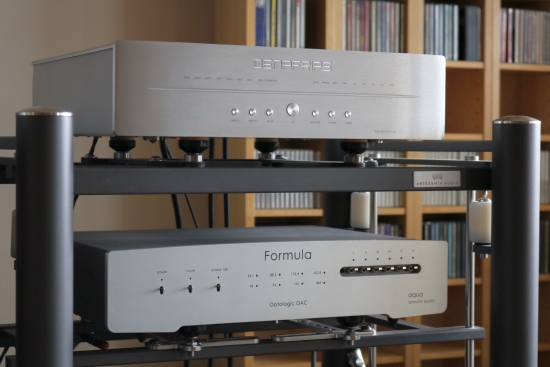
Although I have recently added the AudioQuest Fire interlink to my arsenal and it quickly became my preferred link between the CH DAC and amp, it costs more than the Denafrips DAC which makes it a match that precious few people would probably make. And also, I wanted to use the same brand and model of cable for all connections as part of this review. And thus, I mostly used my other favorite cables, the Driade Flow Link Reference 808 RCA and XLR between DAC and preamp, as well as between preamp and power amp.
NOS/OS and Filtering
Since the Aqua is a non-filtering DAC, I also used the Terminator Plus in the NOS mode. This is indicated by a lit orange LED above the NOS button. Confusingly, the Phase Invert function works in reverse, counter-intuitively using a lit LED to indicate positive phase. When using oversampling (the OS mode), the filter can be switched between slow and fast roll-off. The procedure for this also works confusingly by pressing Mute and then Mode once or twice and then checking a lit 1x LED to indicate slow roll-off or the 1x LED off to indicate a fast roll-off.
I listened to all settings and although I can imagine situations in which one might prefer the oversampled sound either with slow or fast roll-off, I had a preference for the NOS setting (no oversampling and no filtering) as it sounded most articulate and direct.
Warming Up
The unit that I received was already run in but Alvin of Vinshine Audio did warn me to make sure to give the DAC enough time to warm up. Of course, I did so, but that did not stop me from doing a comparison from a cold start. Well, it wasn’t straight out of the box as I did let it acclimatize for a day after delivery but I did listen to it right after switching it on. Well, I must say that I couldn’t fault its reproduction. Maybe it was a little lean and perhaps a little cold, but if this was the unit sounding “bad”, then there must be something in store for later! While listening to the unit for several days, honestly, I can’t say that its sound changed very much. Perhaps it got a little warmer overall and maybe a little bit fuller down below but we’re really talking nuances here.
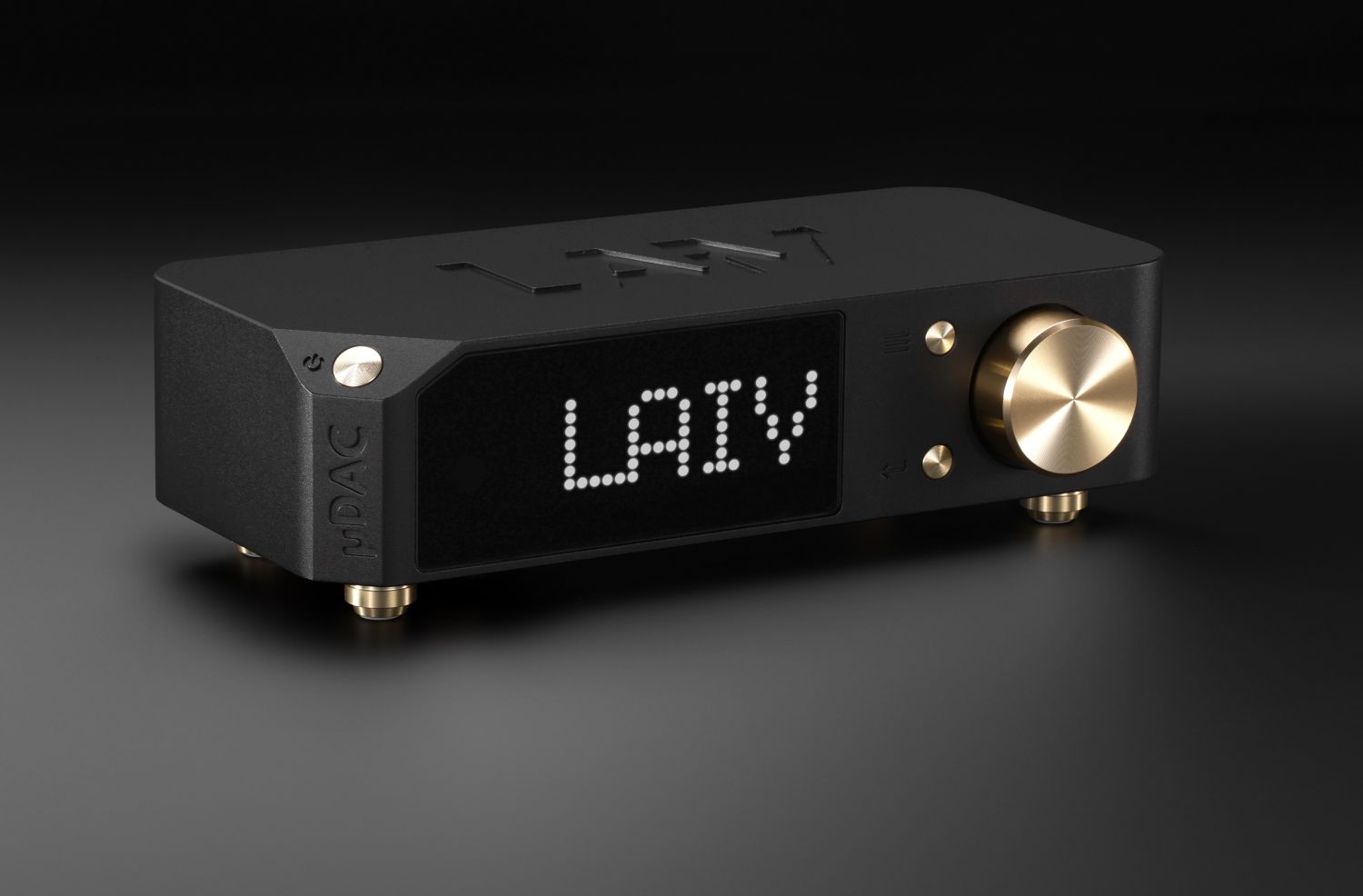






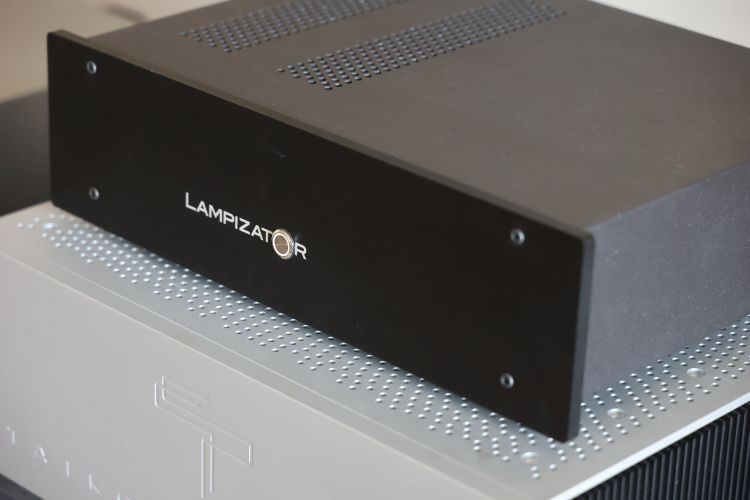
Just another great review. I always check your website and also take a daily look at The Daily Audiophile to see what you’re up to. I wish you could test and compare the MSB Reference ($40,000 US!).
I do the same. The first thing I check on The Daily Audiophile site is for any new reviews on HiFi-advice.
Really liked this review. Especially how you compared the different connections.
Please do add the Audiobyte Hydra stack or any product from Rockna to your review list. Thanks.
Good to hear, Aman! Rockna is on the to do list.
Thanks Vladimir, also nice to hear that people are actively following the Daily Audiophile site. MSB is on the list of things to do:-)
Hi Christiaan, Another great review, it’s especially informative as I know you have had actual experienced with so many excellent units so your comments hold so much more weight for me. I recently received my Antipodes K30 server and presently burning in. Even on first listen I have to agree that it sounds quite quite a leap from my EX. It’s running into my relatively new Sonnet Morpheus Dac which I really like. I was wondering if you have had a chance to try this Dac yet?
Thanks for the great feedback, Rodney. I’ll look into the Sonnet products, can’t promise anything though.
As a TP owner I have experimented with several I2S cables. Improvements are readily apparent with $$ spent. I think you are only scratching the surface with a Sony cable.
I use an inexpensive Denafrips Iris DDC to change USB to I2S while taking advantage of the external clock. You missed the secret sauce. If you try it (or use a Gaia for convert AES/EBU to I2S) and add a good I2S cable you might be brought to tears.
Hi Stephan, indeed, there might be even more to be had because the Jorma AES cable won from the Sony I2S connection in an earlier experiment. Your trick with the Iris DDC sounds interesting but at the end of the day, you’re still using the USB format, only converting it inside the Iris unit rather than in the Terminator. But maybe the clock inside the Iris makes an improvement, that’s certainly possible.
I appreciate the reply Christiaan. I have only compared the USB and I2S inputs of the Terminator. My Innuos Statement outputs USB and Ethernet, the Terminator unfortunately does not take Ethernet input.
Denafrips contends the I2S is the better input over USB so rather than just re-working the USB I am using the better input. I suspect you will agree USB sending and receiving is fraught with potential issues hence all the re-clockers and such.
While the Statement is touted as having a very very good USB output it is made shockingly better with the DDC conversion to I2S.
The Iris’s is a femto clock but it will accept the OXCO clock out from the Terminator so my Iris is running on the Terminators OXCO and that clock is one of the reasons the Terminator sounds so good.
Indeed, how nice would it be if the Denafrips DACs would have Ethernet inputs! But alas. I agree that the quality of the clock is very important (as several experiments with music servers and cd players have shown) and I also agree that I2S is the better connection and that USB has many potential issues. And because its success is so dependent on the implementation of the interfaces on both ends, it’s just not as consistent in its behavior as other connections. Your advice concerning the external I2S conversion while taking advantage of the Terminator’s clock is well noted. Hopefully, this will inspire others to experiment!
Thanks Christian another thorough well written review. You’ve done some excellent reviews of lots of digital gear but I’m pretty sure you’ve never reviewed an Audio Note Dac before. I would suggest you check one out as a bit of a departure from some of the really tech driven Dacs you’ve been reviewing lately. Needless to say a bit of an AN fanboy here with a 26 year old Dac-3 Signature still going strong.
Cheers,
Jon
Hi Jon, Audio Note sure is an interesting brand to take a closer look at. I’ve often heard AN systems or components at shows and in friends’ systems but never have I had a unit in my system. When I get the chance, I will surely take it.
Hi Christiaan
Great review!
Can you please review a small group of R2R dacs, maybe from 800 to 2000 euros? After not really connected with the Chord Qutest (it is very good but it doesn’t excite me) I am looking for one of these myself.
I believe that right now the main “rivals” are models from Denafrips, Musician, Audio-GD and Holo Audio.
There are two possible groups:
Group A: Denafrips Aries Ii vs Musician Draco vs Audio-GD R1 (850 to 950 euros price tag).
Group A: Denafrips Pontus Ii vs Musician Pegasus vs Holo Audio 3 L1 (1250 to 2000 price tag)
I am curious not only the diferences between those in the same price range but also what can be gained if we spend more. (Note: I use a dedicated cd transport an also a streamer)
This comparison would be a huge task but there is nothing on the web like this 🙂
Thanks for a great website and a great youtube channel 🙂
Kind regards
Vasco
Hi Vasco, that’s an excellent suggestion. I’ll see if something like it can be arranged. Can’t make promises, though…
Hi Christiaan
So fingers crossed 🙂
Let me just say that I think that that task is well suited to your way of doing things: your review methodology and equipment, with detailed descriptions and great pictures… but above all excellent writing.
Kind regards
Vasco
You flatter me, Vasco! (blush)
Let’s see if I can get the manufacturers/distributors to work with me on this.
Great review Christiaan. Is it possible to review the Merason DAC 1?
Kind regards
Harry
Thanks Harry. I will check.
Hello Christian interesting review, you can review the Holo May KTE dac, in many forums direct competitor of the terminator. Thanks, best regards
Hi Franco, the Dutch distributor is experiencing difficulties in deliveries for several of their brands. Currently, they prefer delivering to customers over supplying reviewers.
i am using the jorma from my soundaware d300ref streamer to my gaia (both streamer and gaia are clocked with the terra) then and highly recommended tubulus argentus hdmi cable to my terminator plus. the results are stunning.
Hello Christian
very successful review Thank u
I am using denafrips termi plus and hermes ddc. These are very good combo. I want to upgrade denafrips terminator plus. What would u reccomend after denafrips tp.
Hi Bob, to meaningfully improve upon the Terminator Plus, you have to invest serious money. Depending on your personal preferences, you could think of CH-P, MSB, TotalDAC, dCS, or, if you are so inclined, a wide range of Tubed DACs, of which the Lampizator Horizon seems to be the current hot pick (I’ve not heard any of their products). Indeed, these DACs come with very serious price tags. In-between these ultra-high-end DACs and the Terminator, there seems to be a void.
Thank u christiaan ,
What do u think about the weiss 502/501?
Is there an upgrade adter tp? Or just different sound characters ?
Thank u
Yes, there is still an upgrade possible above the Terminator Plus, for instance, the DACs that I mentioned. But for the last 25% in performance (in a manner of speaking), you pay multiples. Please refer to this list: https://www.hifi-advice.com/blog/hfa-awards/ I reviewed the 502, see the review on this site.